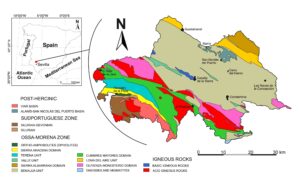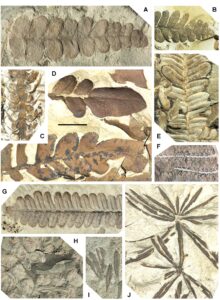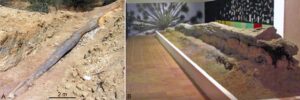Introduction
The origin of the Sierra Norte de Sevilla Geopark lies in the declaration of this region as a Natural Park by Law 2/1989, of 18 July, which approves the Inventory of Protected Natural Spaces of Andalusia. The Natural Park's Management Plan regulates and protects the elements of value in the territory, including the geological heritage. Many geosites of the Carboniferous basins are included in the Andalusian Inventory of Geo-resources and in the Geopark Inventory of Geosites and have been proposed as International Geosites. The geosites inventory registers six localities belonging to this basin, including plant fossils and fossil trunks.
The Carboniferous flora in the Sierra Norte de Sevilla Geopark has been known since the last half of the nineteenth century (Macpherson 1879); it was also recorded by Mallada (1927). The flora occurs in the Alanís-San Nicolás del Puerto and Viar basins (Simon 1941, 1943) and in the Guadalcanal Basin, which lies just outside the northern boundary of the Geopark and is, therefore, not considered here, although it has been widely referenced in the literature.
In Alanís-San Nicolás del Puerto, floral remains were documented by Simon (1941, 1943) and Mingarro (1962) and later, in much more detail, by Broutin (1986), who recognized an Autunian age for this succession. In the Viar Basin, Simon (1941, 1943) described a flora that he assigned to early Rotliegend age, now taken as essentially equivalent to Autunian. Wagner & Mayoral (2007) documented the flora and proposed an Early Permian age, but in a review of the Carboniferous flora of the Iberian Peninsula, Wagner & Álvarez-Vázquez (2010) included the Autunian in the highest Carboniferous (Gzhelian) and assigned an uppermost Stephanian (mid to upper Autunian) age to the Viar succession. Of particular significance are the silicified tree trunks in both basins, reported by Simon (1943), Broutin (1978, 1986), Vozenin-Serra et al. (1991), Sierra and Moreno (2004), and Wagner & Mayoral (2007).
Location
The Alanís-San Nicolás del Puerto Basin (15 km x 4 km) comprises a number of erosionally disconnected outcrop areas within an irregularly defined basin margin. From the southern outcrops located about 600 m northeast of the village of San Nicolás, the basin extends to the NW to the nearby locality of Alanis (Fig. 1). The Viar basin is a narrow, elongate area (33 km x 6 km), striking NW-SE, comprising non-marine Upper Carboniferous sediments in the Viar river valley.

Figure 1. A Geological sketch map with the location of the Viar and San Nicolás del Puerto Carboniferous basins. Modified from TRAGSATEC (2011)
Relevance of These Geosites
Of the two Carboniferous basins in the Geopark, the most important, best studied and with the richest and best-preserved floral record is the Viar basin.
The lower part of the Viar succession contains abundant, well-preserved floral remains belonging to at least 45 taxa. The flora reflects a humid environment with abundant and varied ferns, including arborescent pecopterids: Renaultia lebachensis, Remia pinnatifida (Fig. 2H), Corynepteris angustissima (Fig. 2F), Nemejcopteris feminaeformis, Pecopteris densifolia (Fig. 2G),and Pecopteris puertollanensis among others; pteridosperms (Mixoneura gimmii (Fig. 2D), Odontopteris osmundaeformis (Fig. 2A), and a new species of Alethopteris to be compared with Alethopteris brevis; and sphenopsids: e.g., Calamites multiramis, Annularia carinata (Fig. 2I), Annularia sphenophylloides, Annularia spinulosa (Fig. 2J), Calamostachys tuberculata (Fig. 2C), and Sphenophyllum oblongifolium. Lycopsids are represented by Sigillaria brardii stems. Also recorded are Cordaites leaves and a single, poorly preserved fragment figured as Autunia conferta in Wagner & Mayoral (2007) that Wagner & Álvarez-Vázquez (2010) later attributed to Diplazites sp.

Figure 2. A) Odontopteris osmundaeformis (Schlotheim) Zeiller. B) Pecopteris cf. monyi Zeiller. C) Calamostachys tuberculata (Sternberg) Weiss. D) Mixoneura gimmii (Remy) Wagner. E. Alethopteris cf. brevis Weiss. F) Corynepteris angustissima (Sternberg) Němejc. G) Pecopteris densifolia Göppert. H) Remia pinnatifida (Gutbier) Knight. I) Annularia carinata Gutbier. J) Annularia spinulosa Sternberg. Scale bar = 1 cm for all figured specimens.
Conifers and Dichophyllum flabellifera were found only in the upper part of the succession. These higher levels also contain several horizons with silicified logs that are interpreted to represent hillside forests. As mentioned above, one of the outstanding fossils in the Geopark is a silicified conifer trunk found in 2005 in the site known as Cerro de los Pavones, in Almadén de la Plata municipality, and described by Wagner and Mayoral (2007). This specimen is almost completely preserved and attains a length of some 17 m with a diameter of almost 1 m at the base, tapering to some 25 cm at the top; the silicified specimen weighs some 12 tonnes (Fig. 3A). It is currently exhibited at the Cortijo El Berrocal Visitor Centre (Fig. 3B).

Figure 3. Silicified conifer trunk. A) View of the large, silicified tree trunk, 16.80-meter-long, in situ flat-lying. NW of Cerro de los Pavones Viar Basin. B) Trunk on exhibit at Cortijo El Berrocal Visitor Center, Almadén de la Plata.
Geotourism and Geotrail Potential
The Viar basin is considered a high-level resource within the geological heritage of Sierra Norte de Sevilla Geopark: the geosite inventory registers six localities belonging to this basin, including the plants and fossil trunks.
The geoturism and geotrail potential is high. In the Geo-Tourism Guide of the Sierra Norte de Sevilla Geopark, one of the three major routes runs, in its early part, through the Viar basin, visiting various geosites, among them, the Geosite 26 “Fossil Flora” where the visitor can observe most of the flora and trunks described above.
New short geo-routes have been designed and implemented in 2020 complementing the route of observation of the paleoflora where fluvial-alluvial and volcanic outcrops can be visited (in the case of the Alanís - San Nicolás del Puerto Basin).
Summary
The high historical and scientific value of the Carboniferous deposits in Sierra Norte de Sevilla Geopark lies in the rich and well-preserved fossil flora. This flora is represented by ferns, pecopterid tree ferns, pteridosperms, sphenopsids, and large and abundant silicified conifer trunks. Among the latter, a large specimen, which is one of the most complete and best-preserved in the European fossil record, is currently exhibited in one of the Visitor Centers of the Geopark.
Acknowledgments
This paper has been partially supported by the Research Group RNM276 of the Junta de Andalucía (Spain) and the Science and Technology Research Centre, University of Huelva. We thank John A. Knight, collaborator of the Centro Paleobotánico, Jardín Botánico de Córdoba, for linguistic and content review.
References
Broutin J (1978). Dadoxylon (Cordaioxylon) sp. Grand'Eury, 1877. Note préliminaire sur les bois fossiles du Permien du Río Viar (province de Séville, Espagne). 103e Congrès National des Sociétés Savantes, Nancy, Sciences. 2: 47–52.
Broutin J (1986). Étude paléobotanique et palynologique du passage Carbonifère Permien dans le sud-ouest de la Péninsule Ibérique. Cahiers de Paléontologie, Éditions du CNRS.
Mallada L (1927). Explicación del Mapa Geológico de España. Tomo III. Sistemas Devónico y Carbonífero. Instituto Geológico y Minero de España, 2ª edición, Madrid.
Macpherson J (1879). Estudio geológico-petrográfico del N. de la Provincia de Sevilla. Comunicaciones del Mapa Geológico de España. T VI. Madrid.
Mingarro F (1962). Estudio del Carbonífero del norte de la provincia de Sevilla. Boletín del Instituto Geológico y Minero de España. 73: 468–624.
Sierra S & Moreno C (2004). Cuenca Pérmica del Viar. In: J.A. Vera (ed.), Geología de España: 214–215. Instituto Geológico y Minero de España.
Simon W (1941). Variscische Sedimente der Sierra Morena (Spanien). Die Schichten von San Nicolás del Puerto. Senckenbergiana. 23: 260–266.
Simon W (1943). Variscische Sedimente der Sierra Morena. Die Viar-Schichten. Senckenbergiana. 26: 401–426.
TRAGSATEC (2001). Mapa Geológico del Geoparque Sierra Norte de Sevilla. Junta de Andalucía, Consejería de Medio Ambiente y Ordenación del Territorio. Sevilla.
Vozenin-Serra C, Broutin J &Toutin-Motin N (1991). Bois permiens du Sud-Ouest de l’Espagne et du Sud-est de la France. Implications pour la taxonomie des Gymnospermes paléozoïques et la phylogénie des Ginkgophytes. Palaeontographica, Abt. B. 221: 1–26.
Wagner R & Álvarez-Vázquez C (2010) The Carboniferous floras of the Iberian Peninsula: A synthesis with geological connotations. Review of Palaeobotany and Palynology. 162: 239–324.
Wagner RH & Mayoral E (2007). The Early Permian of Valdeviar in Sevilla province, SW Spain: basin history and climatic/palaeogeographic implications. Journal of Iberian Geology. 33: 93–124.
